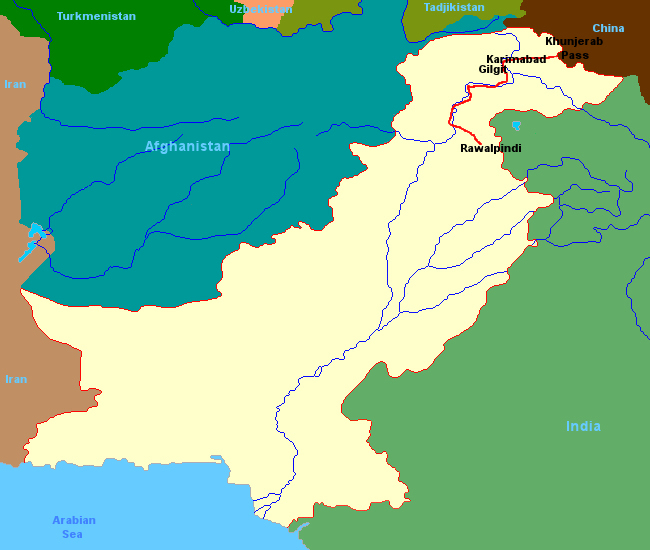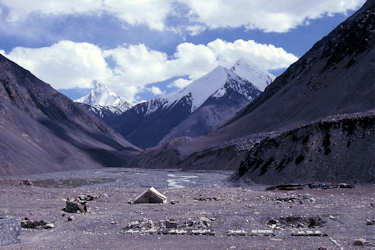Pakistan

Historie
Some of the earliest ancient human civilisations in South Asia originated from areas encompassing present-day Pakistan. The earliest known
inhabitants in the region were Soanian during the Lower Paleolithic, of whom stone tools have been found in the Soan Valley of Punjab.
The Indus region, which covers most of present day Pakistan, was the site of several successive ancient cultures including the Neolithic
Mehrgarh (7.000-2.500 BC) and the Bronze Age Indus Valley Civilisation (2.800–1.800 BC) at Harappa and Mohenjo-Daro.
The Vedic period (1500–500 BC) was characterised by an Indo-Aryan culture; during this period the Vedas, the oldest scriptures
associated with Hinduism, were composed, and this culture later became well established in the region.
Successive ancient empires and kingdoms ruled the region: the Persian Achaemenid Empire (around 519 BC), Alexander the Great's
empire in 326 BC and the Maurya Empire, founded by Chandragupta Maurya and extended by Ashoka the Great, until 185 BC.
The Indo-Greek Kingdom founded by Demetrius I of Bactria (180–165 BC) included Gandhara and Punjab and reached its greatest extent
under Menander I (165–150 BC), prospering the Greco-Buddhist culture in the region.
Taxila had one of the earliest universities and centres of higher education in the world, which was established during the late Vedic
period in 6th century BC. The school consisted of several monasteries without large dormitories or lecture halls where the religious instruction
was provided on an individualistic basis. The ancient university was documented by the invading forces of Alexander the Great and was also recorded
by Chinese pilgrims in the 4th or 5th century AD.
The Indo-Scythians were descended from the Sakas (Scythians) who migrated from southern Central Asia into Pakistan and Arachosia from
the middle of the 2nd century BC to the 1st century BC. They displaced the Indo-Greeks and ruled a kingdom that stretched from Gandhara to Mathura.
The power of the Saka rulers started to decline in the 2nd century AD after the Scythians were defeated by the south Indian Emperor
Gautamiputra Satakarni of the Satavahana dynasty.
Later the Saka kingdom was completely destroyed by Chandragupta II of the Gupta Empire from eastern India in the 4th century AD.
The Rai Dynasty (c. 489–632 AD) which originated in the region of Sindh, ruled much of the Northwestern regions of the Indian subcontinent.
The Pala Dynasty (8th-12th century) was the last Buddhist empire, which, under Dharmapala and Devapala, stretched across
South Asia from what is now Bangladesh through Northern India to Pakistan.
The Early Medieval period (642–1219 AD) witnessed the spread of Islam in the region. During this period, Sufi missionaries played a pivotal role
in converting a majority of the regional Buddhist and Hindu population to Islam.
These developments set the stage for the rule of several successive Muslim empires in the region, including the Ghaznavid Empire (975–1187 AD),
the Ghorid Kingdom (1186-1206 AD), and the Delhi Sultanate (1206–1526 AD). The Lodi dynasty, the last of the Delhi Sultanate, was
replaced by the Mughal Empire (1526–1857 AD).
The gradual decline of the Mughal Empire in the early 18th century enabled the Sikh Empire to control larger areas until the British
East India Company gained ascendancy over South Asia.
A rebellion in 1857 called the Sepoy mutiny of Bengal was the region's major armed struggle against the British Empire and Queen Victoria.
Divergence in the relationship between Hinduism and Islam created a major rift in British India that led to motivated religious violence in
British India.
A Muslim intellectual movement, founded by Sir Syed Ahmed Khan to counter the Hindu renaissance, envisioned, as well as advocated for
the two-nation theory, and led to the creation of the All-India Muslim League in 1906.
The Muslim League slowly rose to mass popularity in the 1930s amid fears of under-representation and neglect of British Muslims in politics. The
perceived neglect of Muslim interests by Congress led British provincial governments during the period of 1937–39 convinced Muhammad Ali Jinnah,
the founder of Pakistan to espouse the two-nation theory and led the Muslim League to adopt the Lahore Resolution of 1940.
As the United Kingdom agreed to the partitioning of India in 1947, the modern state of Pakistan was established on 14 August 1947, amalgamating
the Muslim-majority eastern and northwestern regions of British India. It comprised the provinces of Balochistan, East Bengal, the North-West
Frontier Province, West Punjab, and Sindh.
Democracy was stalled by the martial law that had been enforced by President Iskander Mirza, who was replaced by the army chief, General
Ayub Khan. After adopting a presidential system in 1962, the country experienced exceptional growth until a second war with India in 1965
that led to an economic downturn and wide-scale public disapproval in 1967.
In 1970 Pakistan held its first democratic elections since independence, meant to mark a transition from military rule to democracy, but after
the East Pakistani Awami League won against the Pakistan Peoples Party (PPP), the military establishment refused to hand over power.
Operation Searchlight, a military crackdown on the Bengali nationalist movement, led to a declaration of independence and the waging of a
war of liberation by the Bengali Mukti Bahini forces in East Pakistan. With Pakistan surrendering in the war on
16 December 1971 Bangladesh was gaining independence.
Democracy ended with a military coup in 1977 against the leftist PPP, which saw General Zia-ul-Haq become the president in 1978.
From 1977 to 1988, President Zia's corporatisation and economic Islamisation initiatives led to Pakistan becoming one of the fastest-growing
economies in South Asia.
While building up the country's nuclear program, increasing Islamisation, and the rise of a homegrown conservative philosophy, Pakistan helped
subsidise and distribute US resources to factions of the mujahideen against the USSR's intervention in communist Afghanistan.
With the death of President Zia-ul-Haq in 1988, new general elections saw the victory of PPP led by Benazir Bhutto who was elevated as
the country's first female Prime Minister of Pakistan.
In 1990 New general elections saw the coming of Pakistan Muslim League (N) for the first time with Nawaz Sharif as the Prime Minister
of Pakistan. Sharif focused on privatization and economic liberalisation of Pakistan. However, he was dismissed in 1993 with new general
elections taking place the same year.
These election saw the return of Benazir Bhutto for the second time but she too was dismissed.
The 1997 new general elections saw the return of PML(N) and Nawaz Sharif.
I visited Pakistan in september 1993
On that trip i have seen
Rawalpindi
Gilgit
Karimabad
Khunjerab Pass
Please let me know when you're having questions.
i would be pleased to help you.
Things to do and other tips
